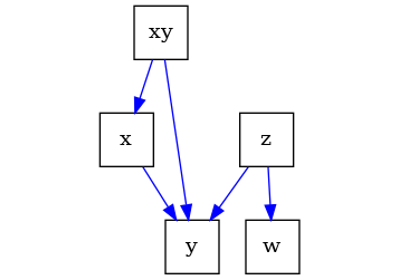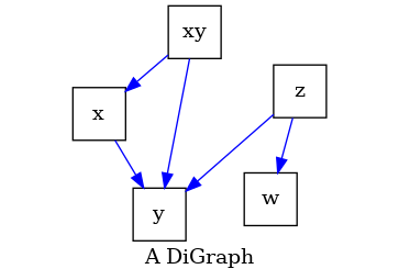pywhy_graphs.CPDAG#
- class pywhy_graphs.CPDAG(incoming_directed_edges=None, incoming_undirected_edges=None, directed_edge_name: str = 'directed', undirected_edge_name: str = 'undirected', **attr)[source]#
Completed partially directed acyclic graphs (CPDAG).
CPDAGs generalize causal DAGs by allowing undirected edges. Undirected edges imply uncertainty in the orientation of the causal relationship. For example,
A - B, can beA -> BorA <- B, allowing for a Markov equivalence class of DAGs for each CPDAG.- Parameters:
- incoming_directed_edgesinput directed edges (optional, default: None)
Data to initialize directed edges. All arguments that are accepted by
networkx.DiGraphare accepted.- incoming_undirected_edgesinput undirected edges (optional, default: None)
Data to initialize undirected edges. All arguments that are accepted by
networkx.Graphare accepted.- directed_edge_namestr
The name for the directed edges. By default ‘directed’.
- undirected_edge_namestr
The name for the directed edges. By default ‘undirected’.
- attrkeyword arguments, optional (default= no attributes)
Attributes to add to graph as key=value pairs.
Notes
CPDAGs are Markov equivalence class of causal DAGs. The implicit assumption in these causal graphs are the Structural Causal Model (or SCM) is Markovian, inducing causal sufficiency, where there is no unobserved latent confounder. This allows CPDAGs to be learned from score-based (such as the “GES” algorithm) and constraint-based (such as the PC algorithm) approaches for causal structure learning.
One should not use CPDAGs if they suspect their data has unobserved latent confounders.
Edge Type Subgraphs
The data structure underneath the hood is stored in two networkx graphs:
networkx.Graphandnetworkx.DiGraphto represent the non-directed edges and directed edges. Non-directed edges in an CPDAG can be present as undirected edges standing for uncertainty in which directino the directed edge is in.- Directed edges (<-, ->, indicating causal relationship) =
networkx.DiGraph The subgraph of directed edges may be accessed by the
CPDAG.sub_directed_graph. Their edges in networkx format can be accessed byCPDAG.directed_edgesand the corresponding name of the edge type byCPDAG.directed_edge_name.
- Directed edges (<-, ->, indicating causal relationship) =
- Undirected edges (–, indicating uncertainty) =
networkx.Graph The subgraph of undirected edges may be accessed by the
CPDAG.sub_undirected_graph. Their edges in networkx format can be accessed byCPDAG.undirected_edgesand the corresponding name of the edge type byCPDAG.undirected_edge_name.
- Undirected edges (–, indicating uncertainty) =
By definition, no cycles may exist due to the directed edges.
- add_edge(u_of_edge, v_of_edge, edge_type='all', **attr)[source]#
Add an edge between u and v.
The nodes u and v will be automatically added if they are not already in the graph.
Edge attributes can be specified with keywords or by directly accessing the edge’s attribute dictionary.
- Parameters:
- u_for_edge, v_for_edgenodes
Nodes can be, for example, strings or numbers. Nodes must be hashable (and not None) Python objects.
- edge_typestr
The edge type. By default ‘all’, which will then add an edge in all edge type subgraphs.
- attrkeyword arguments, optional
Edge data (or labels or objects) can be assigned using keyword arguments.
See also
add_edges_fromadd a collection of edges
- add_edges_from(ebunch_to_add, edge_type, **attr)[source]#
Add all the edges in ebunch_to_add.
- Parameters:
- ebunch_to_addcontainer of edges
Each edge given in the container will be added to the graph. The edges must be given as 2-tuples (u, v) or 3-tuples (u, v, d) where d is a dictionary containing edge data.
- edge_typestr
The edge type to add edges to. By default ‘all’, which will then add an edge in all edge type subgraphs.
- attrkeyword arguments, optional
Edge data (or labels or objects) can be assigned using keyword arguments.
See also
add_edgeadd a single edge
Notes
Adding the same edge twice has no effect but any edge data will be updated when each duplicate edge is added.
Edge attributes specified in an ebunch take precedence over attributes specified via keyword arguments.
- orient_uncertain_edge(u: int | float | str | Any, v: int | float | str | Any) None[source]#
Orient undirected edge into an arrowhead.
If there is an undirected edge u - v, then the arrowhead will orient u -> v. If the correct order is v <- u, then simply pass the arguments in different order.
- Parameters:
- unode
The parent node
- vnode
The node that ‘u’ points to in the graph.
- possible_children(n: int | float | str | Any) Iterator[int | float | str | Any][source]#
Return an iterator over children of node n.
Children of node ‘n’ are nodes with a directed edge from ‘n’ to that node. For example, ‘n’ -> ‘x’, ‘n’ -> ‘y’. Nodes only connected via a bidirected edge are not considered children: ‘n’ <-> ‘y’.
- Parameters:
- nnode
A node in the causal DAG.
- Returns:
- childrenIterator
An iterator of the children of node ‘n’.
- possible_parents(n: int | float | str | Any) Iterator[int | float | str | Any][source]#
Return an iterator over parents of node n.
Parents of node ‘n’ are nodes with a directed edge from ‘n’ to that node. For example, ‘n’ <- ‘x’, ‘n’ <- ‘y’. Nodes only connected via a bidirected edge are not considered parents: ‘n’ <-> ‘y’.
- Parameters:
- nnode
A node in the causal DAG.
- Returns:
- parentsIterator
An iterator of the parents of node ‘n’.
Examples using pywhy_graphs.CPDAG#

An introduction to causal graphs and how to use them

Drawing graphs and setting their layout for visual comparison